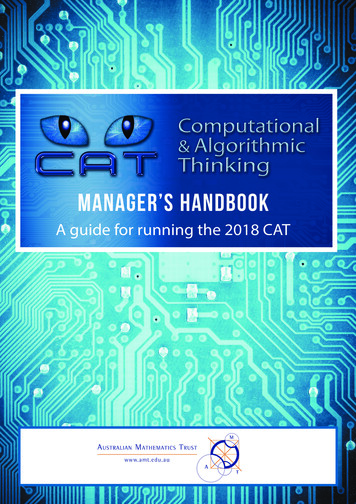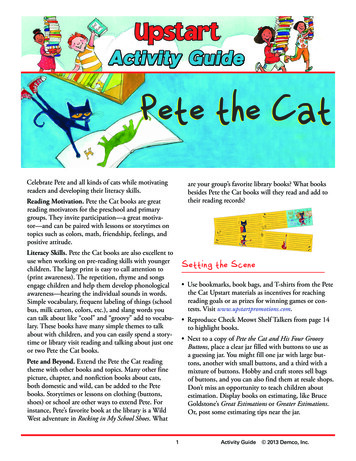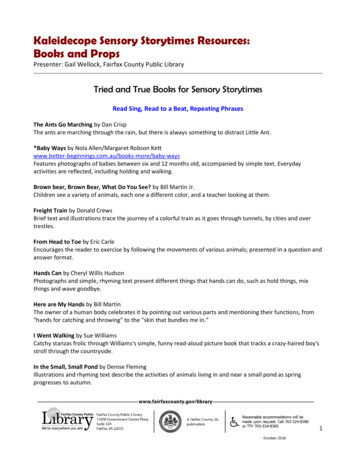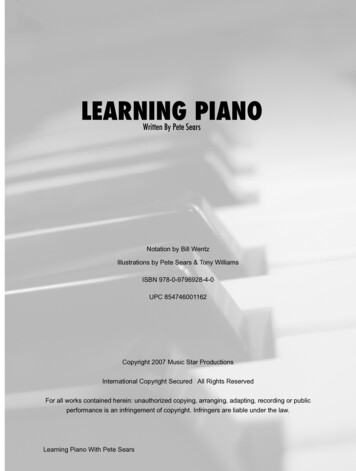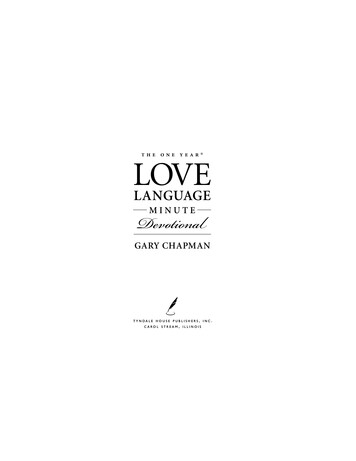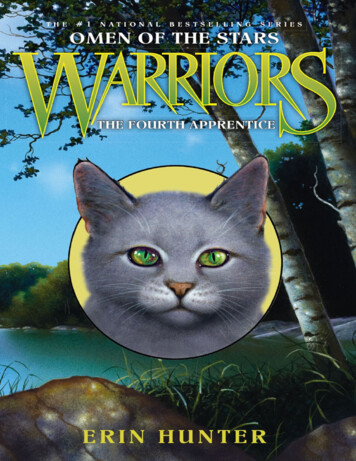
Transcription
Pete the Cat: I Love My White ShoesAuthor: Eric LitwinIllustrator: James DeanְJewish Value: Be Content—Same’ach B’chelko ׂש ֵמ ַח ְּב ֶחלקֹו ַ ה ָכּ ַרת ַAdditional Value: Be Grateful—Hakarat Hatov הטֹוב Enduring Understandings Be content with what you have. “When life gives you a lemon, make lemonade!” Sometimes we can make thesituation better through our attitude, and sometimes by the ways in which we solve theproblem.Book SummaryPete the Cat goes walking down the street wearing his brand-new white shoes. Along the way,his shoes change from white to red to blue to brown to WET, as he steps in piles of strawberries,blueberries, and other big messes! But no matter what color his shoes are, Pete keeps movin’and groovin’ and singing his song because it’s all good!Be Inspired: Consider the ideas included as starting points, as you and your students explore, discover, and live thevalues. Be sure to elicit and encourage student and parent participation, consistently reinforcing the values beingaddressed. Allow lessons to authentically develop and change based on engagement and interests.128
For the EducatorJewish Thought, Text, and Traditions(For more information on Jewish values, visit www.jewishlearningmatters.com.)Same’ach b’chelko literally means “happy or content with one’s lot.” In other words,this Jewish value reminds us that we need to be content with what we have. Thisnot only refers to our belongings, but also implies that we should not envy whatbelongs to others, live in the present moment, be happy with our own talents andaccomplishments, and accept who we are. There is no limit to what we don’thave, and if that is where we focus, then our lives are inevitably filled with endlessdissatisfaction.In essence, we need to be grateful for what we have and who we are. Therefore,same’ach b’chelko is closely connected to another Jewish value, hakarat hatov,gratitude. When we are content with and grateful for what we have, we don’t feelthreatened by the success and good fortune of others. We can celebrate what theyhave by appreciating what is our own. How we feel about ourselves can have animpact on our attitude toward others. As we give thanks, our practice needs to beto recognize and honor what we have received and to be grateful for its sufficiency.Our own contentedness, then, truly is reflective on our perspective on life: the whyand how, the meaning and purpose of our existence in the world. The rabbis ofthe Talmud teach that we should give thanks for the ability to give thanks. Thevery first words we are to speak in the morning are Modeh Ani—I am grateful toYou. Beginning the day with thanks, our eyes are attuned to blessing and our spiritrenewed.Questions for Reflection1. We learn from Pirke Avot 4:3 that we should not underrate the importance ofanything. What is the reasoning for not underrating the importance of anything?2. Do you feel more content when you have a sense that all things have their place?3. What makes you happy, and what are you grateful for?4. How can you incorporate the value of same’ach b’chelko within the classroom?129
Jewish Every Day Incorporate Jewish ValuesStart each morning by singing Modeh Ani and ask students to share a reason to saythank you, every day at your meeting time. Hear and see example of such a ritualhere: http://www.youtube.com/watch?v jlvL32CK-lc.As appropriate, on occasions of disappointment or challenge in the classroom, askstudents to brainstorm how they can become content, happy with the way things are,or what they can do to make the situation “sweeter”.Materials and ResourcesMAteriAlS Copy of Pete the Cat: I Love My White Shoes After the Story: ingredients for lemonade, including lemons, sugar, and water;cupstechnology Interactive read-aloud with author and illustrator: http://www.youtube.com/watch?v nuubmSfIs-u FREE download of the I Love My White Shoes song: at/audio/pete-the-cat.mp3130
Sharing the StoryIntroducing the StoryFor strategies for teaching vocabulary, see Appendix, Vocabulary Strategies.Share the cover of the book, and ask students to share what they know about Petethe Cat, the title character in a series of books. Share with students that one thingyou love about Pete in this story is that he is always content; no matter what happens,he finds a way to be happy with what he has.Help students understand the concept of cause and effect. Create a cause-andeffect chart. Let students help fill it in.Cause (If I )Effect (then .)drop a glass of waterthe glass breaks and the floor gets wet.eat too many cookies(have students complete)stay out in the sun for too long(have students complete)(student suggestion)(have students complete)Explain that throughout this story, Pete the Cat will do some silly things that makehis shoes change color and that you want their help in predicting (or guessing) whatthe effect will be. Suggest they listen to how he deals with the unexpected thingsthat happen.Reading the StoryRead the story aloud, stopping when appropriate to explore illustrations, addresscomments, clarify, predict, and guide students’ understanding of the story and thevalues to be content—same’ach b’chelko and be grateful—hakarat hatov.Pause just before you show each page that indicates what color Pete’s shoes will be,and encourage students to predict what will happen.Praise Pete’s attitude of gratitude and his ability to find ways to make a sticky situationfeel happy and sweet!131
Sharing the StorycontinuedEncourage students to sing along, “I love my shoes,” as well as “read” therepetitive sections together, for example, “Did Pete cry? Goodness no!!!!”After the StoryDiscuss the following questions: How would you describe Pete the Cat? What do you like about Pete the Cat? Do you know people who seem to act like Pete the Cat—always happy or contentwith what they have? What would happen if Pete cried and got upset or angry every time somethinghappened to his shoes? Pete loved his shoes. What things are you grateful or happy to have?Reinforce the concept of cause and effect with students. Ask the following questions: I wonder, if Pete’s shoes were to turn green, where do you think he might havestepped? I wonder, if Pete’s shoes were to turn black (or purple, or any other color), wheredo you think he might have stepped?Teach problem solving by turning lemons into lemonade! Pete was happy even whenunexpected things happened. Involve students in the following to help them enhanceand apply their understanding of gratitude and contentment through problem solving. Give each student a small piece of a lemon. Ask them to taste the lemon anddescribe it. Do they like it? How could they make it taste better? Collect ideas. Involve students in making lemonade: squeezing out the juice and adding water,sugar, and ice. Now have them sample the lemonade. How would they describe the taste? Dothey like it better than the taste of the freshly-squeezed lemons? Share the popular saying, “If you’ve got lemons, make lemonade!” What do theythink this means? Discuss the following scenarios: If you wanted to play outside, but it started to rain, what could you do to makeit “sweeter” and feel content? (make a fort, read a book, pop popcorn and watcha movie) If your family decided to have a playdate with a family you didn’t know, whatcould you do to make it “sweeter” and feel content? (make a new friend, learnabout another family, share your toys and theirs) If you got a cold and couldn’t go to a party, what could you do to make it “sweeter”and feel content? (call the friend who is hosting the party to say something niceand tell them you missed them, plan a different special get-together with friends,have a pajama party with your toys, pets, or family while you are resting)132
Explore, Discover, and MoreExtension and Reinforcement ActivitiesRockin’ GuitarsDramatic Play, Art, MusicThroughout the story, Pete is depicted with his cool guitar. Create tissue-box “guitars”so that the students can play and sing. For each guitar, you will need: a tissue box a sturdy piece of cardboard in the shape of a very narrow rectangle or a papertowel tube for the “neck” several rubber bands, optimally different widths a pencil (or pencil-shaped object) a piece of string or fabric to make a guitar strap, if desired a way to decorate the box and tissues: stickers, contact paper, paint, or markersDirections1. Draw students’ attention to Pete’s guitar and help them identify the head, neck,body, and strings of the instrument. If possible, invite a guitar player to visit yourclassroom to explain the parts and their function.2. Encourage students to decorate their tissue boxes and allow them to drycompletely. If using cardboard, attach the neck of the guitar with glue (a glue gunor other strong adhesive will increase the craft’s durability) or by cutting out a holein the top of the box and sticking the tube with glue into the box. Allow it to dry.3. Help students stretch the rubber bands the long way around the decorated tissuebox with the attached neck and play away! Different shapes and sizes of rubberbands will produce different types of sounds. Stick the pencil underneath thebottom of the tissue box hole to hold up the rubber bands. Attach a strap to theguitar if desired.4. Encourage students to create their own new tunes about the things they love,using their guitars and their imaginations!5. Share the songs and story with the community by visiting classrooms or havinga rockin’ guitar parade!Create an I Love My White Shoes Big BookLiteracy, Music, ArtMake a cover for your book with a title. Complete the cover with your name and yourclass’s name.Mr. / Ms. (teacher’s name) Class: (class name)Students each select something else they might step into and what color their shoesbecome. Help them write a caption on large chart paper, draw the page, and bind. Itmight be fun to create a video, with each child reading his or her own illustrated pageand the class singing the chorus (changing it a bit for each new color).133
Explore, Discover, and MoreExtension and Reinforcement ActivitiescontinuedWe Love Our Paper Shoes!Art, Science Ask each student to trace the outline of his or her shoe on a piece of white paper(copy paper works best) and then ask them to color them with washable markers.You might want to sing, “I love my shoes,” describing each of thestudent’s color choices. Then drop the “shoes” into a bucket of water. If you want the students to get theirown shoes back at the end of the activity, make certain to write their names inpermanent marker on the shoe as well. Ask the students to make predictions and chart what they believe will happento their shoes. Wait 15-20 minutes and then ask the students to remove theirshoes from the water bucket. What happened to their colored shoes? Usually,washable marker soaks off of paper, leaving the paper wet but white.Goodness SeekersMovementInvite students to practice hakarat hatov by asking students to “find the good” invarious situations. Encourage students to explore their environment and accompanythem as they go on a “good” scavenger hunt. Document all their ideas and sharewith the community.134
Music(Access all songs at www.jewishlearningmatters.com/music.)“You Get What You Get” by “Miss” Emily Aronoff TeckTrack # 6 from Good Choices, Volume 1Inspiration TextBen Zoma says, “Who is rich? The one who appreciates what he has” -Pirke Avot 4:1“You Get What You Get” ActivityWhen friends or family become upset, encourage students to use the chorus of thissong to remind them to try to be content.LyricsCHORUSYou get what you get, and you don’t get upsetYou get what you get, and you don’t get upsetAll the toys are great but there is one I like the bestWhen we share toys, I want one more than all the restIf I don’t get what I want, I know I’ll be okayIf I start to get sad, my friends know what to sayCHORUSWhen I sit at the table and it’s time to eatI know I should eat healthy foods but I want something sweetI see what’s on my plate, and I sorta want to cryBut I make a better choice and give new healthy foods a tryCHORUSIt is time for bed, time to read with Mom or DadThey let me choose two books, but I want more and I get madI’m cranky and it’s late, and I see my parents sigh‘Til I have a good idea, sing this as a lullaby CHORUS135
MusiccontinuedI’ve slept all through the night. I’m in a happy morning moodI’m thinking about this song and about my attitudeWith a small shift in how I think, I will better understandIf I’m grateful, I’ll feel rich, feel my life is truly grand!New CHORUSI have what I have, and I am quite gladI’ve got what I’ve got, I’m content with my lotI have what I have, and I am quite gladI’ve got what I’ve got, I’m content with my lotAdditional Music ConnectionsTo access additional Jewish and secular songs from a variety of traditionaland contemporary artists that reinforce and teach these values, visit www.jewishlearningmatters.com/music.Evidence of LearningThrough the various activities, discussions, and problem-solving scenarios, studentscan articulate what it means to be content or happy with what they have.Home and Community ConnectionsEncourage families to learn more about the values and reinforce the concepts withtheir children through video and song by visiting www.jewishlearningmatters.com.Hold a school-wide shoe drive to donate shoes to children, explaining that there aremany children in our community who don’t have shoes to wear.Send a note home to families about the “lemons into lemonade” activity, encouragingthem to involve children in problem solving and finding ways to “make things sweeter”when a challenge arises.136
Literature ConnectionsTitleAuthor(s) and SummaryIllustrator(s)Let theWholeEarth SingPraiseTomie dePaolaInspired by biblical scripture and the folk art of the Otomipeople of Puebla, Mexico, this small picture book praisesthe goodness and beauty of G-d’s creation. Throughsong-like verse and tropical-hues collage, it extols the joyto be found everywhere you look—from land, sea, andsky to all of humanity.The OKBookAmy KrouseRosenthalThis book plays on words to help children discover thatsometimes something that seems just “OK” can actuallybe great.Tom LichtenheldHow FullIs YourBucket?For KidsTom Rathand MaryReckmeyerIt CouldAlways BeWorse*Margot SemachMaurieJ.ManningThrough the story of a little boy named Felix, thischarming book explains to children how being kindnot only helps others, it helps them, too. As he goesabout his day, Felix interacts with different people— his sister Anna, his grandfather, other family andfriends. Some people are happy, but others aregrumpy or sad. Using the metaphor of a bucket anddipper, Felix’ grandfather explains why the happypeople make Felix feel good, while the others leavehim feeling bad — and how Felix himself is affectingothers, whether he means to or not.Once upon a time a poor unfortunate man lived with hismother, his wife, and his six children in a one-room hut.Because they were so crowded, the children oftenfought and the man and his wife argued. When thepoor man was unable to stand it any longer, he ran tothe Rabbi for help.In his little hut, silly calamity followsfoolish catastrophe, all memorably depicted in full-colorillustrations that are both funnier and lovelier than anythis distinguished artist has done in the past.*PJ Library Book137
Thematic ConnectionsPete the Cat SeriesCause and effectMusic: guitarsThanksgivingLESSON CONTRIBUTOREmily Aronoff TeckGlantz ECC at the Mandel JCC, Boynton Beach, Florida138
Pete the Cat goes walking down the street wearing his brand-new white shoes. Along the way, . FREE download of the I Love My White Shoes song: . Materials and Resources. 131 Explain that throughout this story, Pete the Cat will do some silly things that make his shoes change color an
